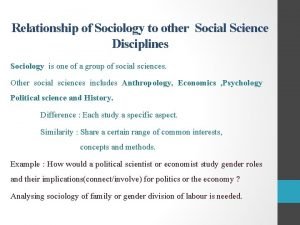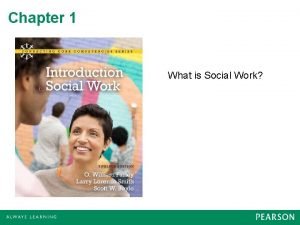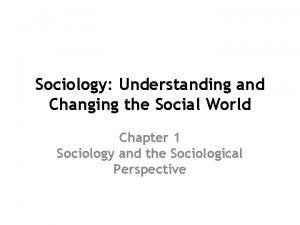Population and Food Michael Itagaki Sociology 102 Social




































- Slides: 36

Population and Food Michael Itagaki Sociology 102, Social Problems

The Problem in Sociological Perspective n How many people in the U. S. u n n Each day, Americans buy an average of Eggs: u n 58, 863, 993 Orville Redenbacher popcorn u n 303 million 978, 030 Large Fries at Burger King u 443, 650

The Problem in Sociological Perspective n Demography u Studies the size, composition, growth and distribution of human populations

The Problem in Sociological Perspective n World Population Abrupt increases: ex. population in Europe u 1750— 140 million people u 1800— 188 million people u 1850— 256 million people u

The Problem in Sociological Perspective n World Population u u u Why the increase? Improved public health Thomas Mc. Keown Infanticide practice declined after 1750 « Why? «

The Problem in Sociological Perspective n Demography u u Studies the size, composition, growth and distribution of human populations Relationship between population and the environment

The Problem in Sociological Perspective n Thomas Malthus (1798) u u u An Essay on the Principle of Population grows exponentially 2 to 4 to 8 to 16… = 2 x Food supply increases arithmetically 1 to 2 to 3 to 4… = x+1

The Problem in Sociological Perspective n Thomas Malthus (1798) Exponential growth: Penny example u 1 day, 1 cent; 2 days, 2 cents; 3 days, 4 cents u One week = $ 1. 28 u Two weeks = $ 163. 84 u Three weeks = $ 20, 971. 52 u Four weeks = $2, 684, 354. 56 u

The Problem in Sociological Perspective n New Malthusians u Exponential population growth curve

Figure 13. 1 (p. 424) World Population: The Exponential Growth Curve Sources: Piotrow 1973: 4; Haub 1995, 2004.

The Problem in Sociological Perspective n New Malthusians u u n Exponential population growth curve Population will outgrow food supply Anti-Malthusians u u Exponential population growth curve is wrong People adapt to the environment

The Problem in Sociological Perspective n Anti-Malthusians u u Rational planning for having children Increased food production « u Technology/Agriculture Ex. : Europe’s demographic transition Figure 13 -3

Figure 13. 3 (p. 426) The Demographic Transition Source: By the author.

Figure 13. 1 (p. 424) World Population: The Exponential Growth Curve Sources: Piotrow 1973: 4; Haub 1995, 2004.

The Problem in Sociological Perspective n Anti-Malthusians u u Growth is slowing down Demographic transition for rest of world

The Scope of the Problem n New-Malthusians u u n Population growth = not enough food Solution: limit population Anti-Malthusians u u More food available now than ever Solution: Redistribution of food (political barriers)

Symbolic Interactionism n Why do the poor want so many children? u u Asset to the family Taking the role of the other

Figure 13. 6 (p. 432) Why the Poor in the Least Industrialized Nations Want Many Children Based on a survey in Indonesia, this figure shows how children are economic assets in the Least Industrialized Nations. Boys and girls can be net income earners for their families by the age of 9 or 10. Source: U. N. Fund for Population Activities.

Functionalism n War, famine, disease are functional to society u Latent dysfunctions Modern medicine « Public health practices «

Figure 13. 3 (p. 426) The Demographic Transition Source: By the author.

Figure 13. 7 (p. 433) Population Pyramids of Mexico and the United States Source: By the author. Computed from the U. S. Bureau of the Census, International Data Base, Table 94.

Conflict Theory n Power arrangements favor industrialized nations u Ex. U. S. & Canada control 60% of wheat Sell surpluses for highest profit… « not to the most needy « Leaving farm land fallow: profit vs. production «

Research Findings n New Malthusians

Figure 13. 1 (p. 424) World Population: The Exponential Growth Curve Sources: Piotrow 1973: 4; Haub 1995, 2004.

Research Findings n New Malthusians u The earth’s three natural systems u Limited carrying capacity

Research Findings n New Malthusians u Fishing Grounds u Forests u Grasslands

Research Findings n New Malthusians u Major Dangers « Disease of Specialized Strains « Intensification of natural disasters « World peace threatened:

Research Findings n Anti Malthusians

Figure 13. 3 (p. 426) The Demographic Transition Source: By the author.

Research Findings n Anti Malthusians u Large populations are good u Food production is outpacing population growth

Figure 13. 4 (p. 428) How Much Food Does the World Produce Person? Source: U. S. Department of Agriculture, Simon 1981: 58; Statistical Abstract 1988: Table 1411; 1998: Tables 1380, 1381, 1382, 1383; recomputed to 1948 -52 base. Note: Projections from 1997 on are the author's.

Immigration and the U. S. Population Composition n n Proportion of immigrants in the U. S. population is the highest since 1940 Immigration will account for two-thirds of the population growth in the next 50 years Immigration leads to higher taxes but also brings substantial economic benefits U. S. population policies focus on immigration – particularly illegal immigrants

Discussion Question n Should the United States Should simply close its doors to all immigrants? u What would be the consequences of doing so? u How would such a move reflect on our national values and priorities?

Figure 13. 13 a (p. 443) Density of Selected Countries (continued on next two slides)

Figure 13. 13 b (cont. )

Figure 13. 13 c (cont. )
 Michael itagaki
Michael itagaki Michael itagaki
Michael itagaki Michael itagaki
Michael itagaki Michael itagaki
Michael itagaki Michael itagaki
Michael itagaki Michael itagaki
Michael itagaki Convenio oit 102
Convenio oit 102 Chapter 4 population ecology section 1 population dynamics
Chapter 4 population ecology section 1 population dynamics Section 1 population dynamics answer key
Section 1 population dynamics answer key Population ecology section 1 population dynamics
Population ecology section 1 population dynamics Chapter 4 section 1 population dynamics answer key
Chapter 4 section 1 population dynamics answer key Sociology understanding and changing the social world
Sociology understanding and changing the social world Difference between sociology and other social sciences pdf
Difference between sociology and other social sciences pdf Deviants chapter 8
Deviants chapter 8 Distinguishing characteristics of social work
Distinguishing characteristics of social work Debunking motif definition
Debunking motif definition Unit 2 food food food
Unit 2 food food food Sequence of food chain
Sequence of food chain Social change in sociology
Social change in sociology Social psychology vs sociology
Social psychology vs sociology Media consolidation sociology definition
Media consolidation sociology definition Pictures of social institutions
Pictures of social institutions Social stratification definition
Social stratification definition Characteristics of social groups
Characteristics of social groups Social structure definition sociology
Social structure definition sociology Sociology vs social psychology
Sociology vs social psychology Factors of social change sociology
Factors of social change sociology Sociology
Sociology Social movement examples
Social movement examples Different types of social groups
Different types of social groups Social mobility definition sociology
Social mobility definition sociology Conflict theory of social stratification
Conflict theory of social stratification Social psychology vs sociology
Social psychology vs sociology Sociology social groups
Sociology social groups Social process that gets things done
Social process that gets things done Social inequality examples
Social inequality examples Anomie definition sociology
Anomie definition sociology




















































